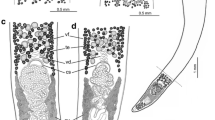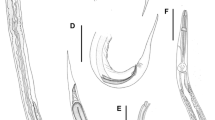Abstract
The proteocephalid genus Pseudoendorchis (Cestoda: Onchoproteocephalidea) has recently been proposed to accommodate seven species/species-level lineages of tapeworm parasites of catfishes (Siluriformes) in the Neotropical region, based on integration of genetic information, and morphological and ecological data. Its members are typified by having a large Mehlis’ gland, representing more than 1/5 (usually 1/4–1/2) of proglottid width, and the vagina always anterior to the cirrus-sac. Critical examination of previously unstudied museum cestodes tentatively designated as Pseudoendorchis sp. 3 from Megalonema platycephalum (Pimelodidae) in the Peruvian Amazon made it possible to formally describe this taxon and to differentiate it from all congeneric species. The new species, which is the first parasite of M. platycephalum ever recorded, is characterised mainly by having the scolex bearing four uniloculate suckers (biloculate in all nominal species of the genus), the lowest relative surface of the ovary (ratio of its surface to that of the whole proglottid) among species of the genus (< 9% versus > 11%, usually 15–20%), and an extraordinarily large Mehlis’ gland (its diameter represents 41–50% of proglottid width). Morphology of the terminal portion of the vaginal canals in proteocephalids is briefly discussed.





Similar content being viewed by others
Data availability
All data generated or analysed during this study are included in the article.
References
Alves, P. V., de Chambrier, A., Luque, J. L., & Scholz, T. (2021a). Integrative taxonomy reveals hidden cestode diversity in Pimelodus catfishes in the Neotropics. Zoologica Scripta, 50, 210–224. https://doi.org/10.1111/zsc.12465
Alves, P. V., de Chambrier, A., Luque, J. L., Takemoto, R. M., Tavares, L. E. R., & Scholz, T. (2021b). New arrangement of three genera of fish tapeworms (Cestoda: Proteocephalidae) in catfishes (Siluriformes) from the Neotropical Region: taxonomic implications of molecular phylogenetic analyses. Parasitology Research, 120, 1593–1603. https://doi.org/10.1007/s00436-021-07138-3
Alves, P. V., de Chambrier, A., Scholz, T., & Luque, J. L. (2017). Annotated checklist of fish cestodes from South America. ZooKeys, 650, 1–205. https://doi.org/10.3897/zookeys.650.10982
Arredondo, N. J., & Gil de Pertierra, A. A. (2010). Monticellia santafesina n. sp. (Cestoda: Proteocephalidea), a parasite of Megalonema platanum (Günther) (Siluriformes: Pimelodidae) in the Paraná River basin, Argentina. Systematic Parasitology, 76, 103–110. https://doi.org/10.1007/s11230-010-9238-y
Caira, J. N., & Jensen, K. (2017). Planetary Biodiversity Inventory (2008–2017): Tapeworms from Vertebrate Bowels of the Earth. Special Publication No. 25. Lawrence, KS: University of Kansas, Natural History Museum.
Chervy, L. (2009). Unified terminology for cestode microtriches: A proposal from the International Workshops on Cestode Systematics in 2002–2008. Folia Parasitologica, 56, 199–230. https://doi.org/10.14411/fp.2009.025
de Chambrier, A., Alves, P. V., Schuster, R. K., & Scholz, T. (2021). Ophiotaenia echidis n. sp. (Cestoda: Proteocephalidae) from the saw-scaled viper, Echis carinatus sochureki Stemmler (Ophidia: Viperidae), one of the world deadliest snakes, from the United Arab Emirates. International Journal for Parasitology: Parasites and Wildlife, 14, 341–354. https://doi.org/10.1016/j.ijppaw.2021.03.006
de Chambrier, A., Binh, T. T., & Scholz, T. (2012). Ophiotaenia bungari n. sp. (Cestoda), a parasite of Bungarus fasciatus (Schneider) (Ophidia: Elapidae) from Vietnam, with comments on relative ovarian size as a new and potentially useful diagnostic character for proteocephalidean tapeworms. Systematic Parasitology, 81, 39–50. https://doi.org/10.1007/s11230.011.9320.0
de Chambrier, A., Kuchta, R., & Scholz, T. (2015). Tapeworms (Cestoda: Proteocephalidea) of teleost fishes from the Amazon River in Peru: Additional records as an evidence of unexplored species diversity. Revue Suisse de Zoologie, 122, 149–163. https://doi.org/10.5281/zenodo.14580
de Chambrier, A., & Scholz, T. (2005). Redescription of Houssayela sudobim (Woodland, 1935) (Cestoda: Proteocephalidea), a parasite of Pseudoplatystoma fasciatum (Pisces: Siluriformes) from the River Amazon. Systematic Parasitology, 62, 161–169. https://doi.org/10.1007/s11230-005-5487-6
de Chambrier, A., Scholz, T., Mariaux, J., & Kuchta, R. (2017). Onchoproteocephalidea I Caira, Jensen, Waeschenbach, Olson & Littlewood, 2014. In J. Caira, & K. Jensen (Eds.), Planetary Biodiversity Inventory (2008–2017): Tapeworms from Vertebrate Bowels of the Earth (Special Publication No 25, pp. 251–277). University of Kansas, Natural History Museum.
de Chambrier, A., & Vaucher, C. (1994). Etude morpho-anatomique et génétique de deux nouveaux Proteocephalus (Cestoda: Proteocephalidae) parasites de Platydoras costatus (L.), poisson siluriforme du Paraguay. Systematic Parasitology, 27, 173–185. https://doi.org/10.1007/BF00008479
de Chambrier, A., & Vaucher, C. (1999). Proteocephalidae et Monticellidae (Eucestoda: Proteocephalidea) parasites de poissons d’eau douce au Paraguay, avec descriptions d’un genre nouveau et de dix espèces nouvelles. Revue Suisse de Zoologie, 106, 165–240. https://doi.org/10.5962/bhl.part.80074
de Chambrier, A., Vaucher, C., & Renaud, F. (1992). Etude des caractères morpho-anatomiques et des flux géniques chez quatre Proteocephalus (Cestoda: Proteocephalidae) parasites de Bothrops jararaca du Brésil et description de trois espèces nouvelles. Systematic Parasitology, 23, 141–156. https://doi.org/10.1007/BF00009156
de Chambrier, A., Zehnder, M. P., Vaucher, C., & Mariaux, J. (2004). The evolution of the Proteocephalidea (Platyhelminthes, Eucestoda) based on an enlarged molecular phylogeny, with comments on their uterine development. Systematic Parasitology, 57, 159–171. https://doi.org/10.1023/B:SYPA.0000019083.26876.34
Froese, R., & Pauly, D. (2021). Fishbase. World Wide Web electronic publication. www.fishbase.org, version (03.2021)
ICZN. (2012). International Commission on Zoological Nomenclature: Amendment of articles 8, 9, 10, 21 and 78 of the International Code of Zoological Nomenclature to expand and refine methods of publication. ZooKeys, 219, 1–10. https://doi.org/10.3897/zookeys.219.3994
Kohn, A., Moravec, F., Cohen, S. C., Canzi, C., Takemoto, R. M., & Fernandes, B. M. M. (2011). Helminths of freshwater fishes in the reservoir of the Hydroelectric Power Station of Itaipu, Paraná, Brazil. Check List, 7, 681–690. https://doi.org/10.15560/7.5.681
Lundberg, J. G., & Dahdul, W. M. (2008). Two new cis-Andean species of the South American catfish genus Megalonema allied to trans-Andean Megalonema xantum, with description of a new subgenus (Siluriformes: Pimelodidae). Neotropical Ichthyology, 6, 439–454. https://doi.org/10.1590/S1679-62252008000300018
Moravec, F. (1998). Nematodes of freshwater fishes of the Neotropical region. Academia.
Petter, A. J. (1995). Dichelyne moraveci n. sp., parasite de Pseudoplatystoma fasciatum et notes sur les Cucullanidae du Paraguay. Revue Suisse de Zoologie, 102, 769–778. https://doi.org/10.5962/bhl.part.80481
Pleijel, F., Jondelius, U., Norlinder, E., Nygren, A., Oxelman, B., Schander, C., Sundberg, P., & Thollesson, M. (2008). Phylogenies without roots? A plea for the use of vouchers in molecular phylogenetic studies. Molecular Phylogenetics and Evolution, 48, 369–371. https://doi.org/10.1016/j.ympev.2008.03.024
Rego, A. A. (1994). The Order Proteocephalidea Mola, 1928. In L. F. Khalil, A. Jones, & R. A. Bray (Eds.), Keys to the Cestode Parasites of Vertebrates (pp. 257–293). CAB International.
Rego, A. A. (1999). Scolex morphology of proteocephalid cestodes parasites of Neotropical freshwater fishes. Memórias Do Instituto Oswaldo Cruz, 94, 37–52. https://doi.org/10.1590/S0074-02761999000100011
Scholz, T., Choudhury, A., & Brooks, D. R. (2019). A new species of Synbranchiella (Cestoda: Proteocephalidae) from the mountain mullet (Dajaus monticola) in Costa Rica. Journal of Parasitology, 105, 79–84. https://doi.org/10.1645/18-71
Scholz, T., & Hanzelová, V. (1998). Tapeworms of the genus Proteocephalus Weinland, 1858 (Cestoda: Proteocephalidae) parasites of fishes in Europe. Studie AV CR, No 2/98. Academia.
Scholz, T., & Kuchta, R. (2017). A digest of fish tapeworms. Vie et Milieu, 67, 43–58
Acknowledgements
The authors are indebted to the late Martin Mortenthaler (Iquitos) and to Roman Kuchta, Carlos A. Mendoza-Palmero (both České Budějovice), Sophie de Chambrier (Fribourg) and Sandrine Coquille (Geneva) for help with collecting and examining fish in Iquitos, Peru in 2009. Technical assistance of Blanka Škoríková of the Institute of Parasitology, BC CAS, České Budějovice, and Janik Pralong and Gilles Roth, both of the Natural History Museum, Geneva, and helpful suggestions of two anonymous reviewers are also much appreciated.
Funding
This work was partially funded by CAPES (postdoc scholarship to PVA, grant 88887.508591/2020-00), NSF-PBI awards (grants 0818696 and 0818823), and the Institute of Parasitology (RVO: 60077344).
Author information
Authors and Affiliations
Corresponding author
Ethics declarations
Conflict of interest
The authors declare that they have no conflict of interest.
Additional information
Publisher's Note
Springer Nature remains neutral with regard to jurisdictional claims in published maps and institutional affiliations.
Rights and permissions
About this article
Cite this article
Alves, P.V., de Chambrier, A. & Scholz, T. Description of the first species of Pseudoendorchis (Cestoda: Proteocephalidae) with uniloculate suckers from the pimelodid catfish Megalonema platycephalum, with comments on the taxonomic importance of the terminal vagina. Syst Parasitol 98, 535–545 (2021). https://doi.org/10.1007/s11230-021-09994-0
Received:
Accepted:
Published:
Issue Date:
DOI: https://doi.org/10.1007/s11230-021-09994-0




